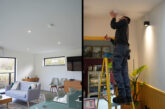
Martyn Walley, National Technical Manager at Aico discusses how changes to private rental sector law could impact on you and your clients.
A significant change in the law came into effect in England on the 1st October 2015; for the very first time, legislation came into force to compel landlords in the private sector to retrospectively fit smoke and Carbon Monoxide (CO) alarms.
I use the word ‘significant’ for good reason as the private rental sector is relatively unregulated, even though it is rapidly growing, with greater numbers of people forced to rely on it as house prices rise and social housing declines.
What has changed?
The new law is in many ways quite straightforward. Here is a summary of the legislation:
• Landlords must fit a smoke alarm on every storey
• Landlords must fit a CO alarm in every room with a solid fuel burning appliance
• Alarms must be tested and working on the start of each tenancy
• Penalties of up to £5,000 will be enforced by the relevant Local Authority for those that flaunt the rule.
Although the legislation only specifically requires a CO alarm in rooms with a solid fuel burning appliance, the accompanying Q&A booklet states in relation to gas appliances that: ‘we would expect and encourage reputable landlords to ensure that working carbon monoxide alarms are installed in rooms with these [gas appliances]’. In fact, best practice dictates CO alarms be installed in rooms that have any fuel burning appliances; where people spend the most time; where people sleep; and in each room that a flue runs through or alongside.
What alarm types should be used?
Where the legislation is less prescriptive is in the types of  alarms to be installed. This has been left as: ‘Landlords should make an informed decision and choose the best alarms for their properties and tenant.’ Even though there hasn’t been a reference to the type and siting of alarms, Aico recommends that the British Standard BS EN 50292:2013 should be adhered to when fitting CO Alarms in residential/domestic premises in accordance with Building Regulations; and that the British Standard BS 5839-6:2013 should be adhered to when fitting smoke alarms.
alarms to be installed. This has been left as: ‘Landlords should make an informed decision and choose the best alarms for their properties and tenant.’ Even though there hasn’t been a reference to the type and siting of alarms, Aico recommends that the British Standard BS EN 50292:2013 should be adhered to when fitting CO Alarms in residential/domestic premises in accordance with Building Regulations; and that the British Standard BS 5839-6:2013 should be adhered to when fitting smoke alarms.
Why quality premium alarms are vital
Landlords could easily go down the route of buying the cheapest battery alarms they can find, install them on the ceiling and then test each alarm individually when a new tenant moves in. If you have private landlord customers – especially those with multiple properties – it’s worthwhile pointing out the drawbacks of this approach.
Firstly, the use of mains powered alarms in tenanted properties is seen as best practice as the issue of battery replacement (or lack thereof) is a serious cause for concern.
Secondly, smoke and CO alarms are life saving products. Pay less, get less; it really is that simple.
Thirdly, the private rental sector has a relatively high turnover of tenants. Testing each alarm manually with every change of tenant is time consuming. And how does the landlord prove they have done it?
Three key recommendations you can make
There are options here to make the landlord’s life easier, to make the tenants safer and to increase your bottom line. Here are three key recommendations to make to your clients:
1. Battery removal from alarms is a big problem in rented properties. According to the Government’s ‘Fire Statistics: Great Britain April 2013 to March 2014’ in dwelling fires where a smoke alarm was present, 39% of all battery-powered smoke alarms failed compared to just 20% of mains-powered alarms in 2013-14. Installing mains powered alarms, or 10-year alarms with sealed in Lithium batteries such as Aico’s Ei160e and Ei208 CO range, overcomes this.
2. Interconnect the alarms within a property to increase audibility and give the tenants the best chance of exiting the property safely. The use of wireless alarm interconnection, such as Aico’s RadioLINK, is ideal here as it won’t require the landlord to undertake redecoration or cause any disruption to tenants.
“Interconnect the alarms within a property to increase audibility and give the tenants the best chance of exiting the property safely.”
3. Fit alarms with easy to use data retrieval technology to provide proof of testing. Aico’s AudioLINK, for example, enables a report on each alarm to be downloaded on to any tablet or smartphone using a free App. AudioLINK is contained in all new Aico CO alarms and its new Multi-Sensor Fire Alarm (Ei2110e).
These simple suggestions could make all the difference to tenants in England, provide peace of mind for landlords and represent a good business opportunity for you, especially when you bear in mind there are more households renting from private landlords today than at any time since the 1960s. That’s a lot of homes and a lot of people to protect.








